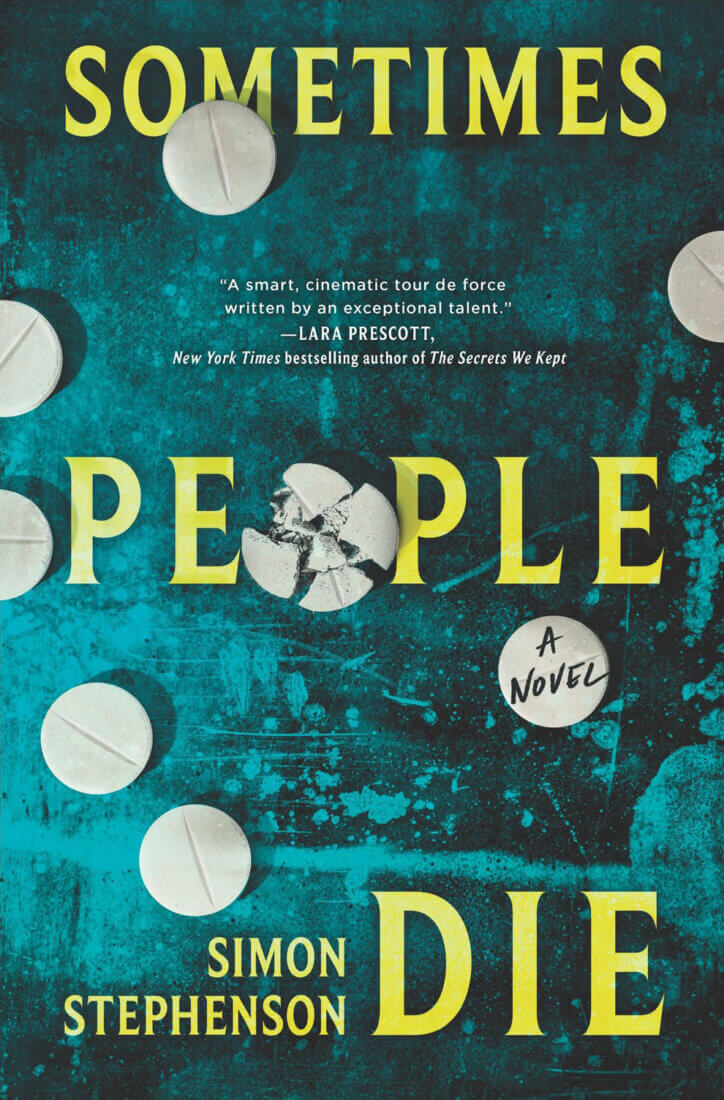A fictitious waterway plays a major role in William Kent Krueger’s mesmerizing new novel, The River We Remember, so it seems more than fitting when Krueger says, “Your first order of business as a storyteller is to hook your reader.”
And boy does he, like a seasoned angler reeling in a prizewinning bass. At the end of a short prologue, after describing how the Alabaster River snakes across Black Earth County, Minnesota, in “a crooked course like a long crack in a china plate,” Krueger describes the catfish that feed along the bottom before announcing “This is the story of how they came to eat Jimmy Quinn.”
“I had that opening in mind for a very long time before I actually sat down to write the story itself,” Krueger says, speaking by phone from his home in St. Paul, Minnesota. The author of 19 Cork O’Connor mysteries adds, “I’m very fond of both prologues and epilogues,” which he believes have distinct purposes: the prologue gives readers “a sense of the story that they’re about to be a part of,” and the epilogue is his way of not leaving them “high and dry, wondering about what happened to characters after the story ends.”
“That’s really where my heart is. . . . Whenever I write a story, I love to just tap into that small town sensibility.”
The River We Remember is set in 1958, when the gruesome discovery of Quinn’s body in the river casts a deep shadow on the town of Jewel’s Memorial Day festivities. Quinn is the richest man and largest landowner in the area—and someone whom no one seems to like, not even his family. It’s up to Sheriff Brody Dern to get to the bottom of how Quinn came to such an ignominious end. Upon hearing the news, Brody is playing chess in the county jail with a prisoner, an otherwise law-abiding widower prone to frequent, disruptive Wild Turkey-fueled benders that land him temporarily behind bars. The friendly, avuncular scene is reminiscent of “The Andy Griffith Show.”
Krueger laughs at the comparison, saying, “I don’t have a Barney Fife in my story, but yes.” Although The River We Remember is far from a comedy, he imbues Jewel and its intricate, long-established community with rare authenticity and warmth. The author explains that although he and his wife have lived in St. Paul for many years, he spent much of his childhood moving from place to place, living in farm towns in states like Ohio, Oregon and California. “That’s really where my heart is,” he admits. “Whenever I write a story, I love to just tap into that small town sensibility.”
The townsfolk include a diverse cast of multigenerational characters, such as retired sheriff Conrad Graff, who helps Brody investigate, and 14-year-old Scott Madison, born with a hole in his heart, who delivers meals to prisoners from his mother’s cafe. This young character, Krueger says—one of his favorites—is much like he was as an adolescent, especially in his “desire to see the world, experience it, and somehow prove to everybody that he really is a man.” With his trademark finely chiseled prose and taut plotting, Krueger uses his characters to explore a variety of themes, including racism, prejudice, war, violence, manhood, justice and redemption. “One of the things that I’m aware of,” Krueger says, “is that if you write a popular mystery series, readers are going to be a little reluctant to follow you to a place that doesn’t have all of the series’ characters and elements in it. When I set out to write this book, I wanted to write a mystery first and foremost, and then use that mystery to explore other themes.”
When The River We Remember’s similarities to To Kill a Mockingbird are mentioned, Krueger says the book is his favorite American novel, “so it’s no surprise that I’m probably greatly influenced in every story by Harper Lee.” However, he says the comparison is more apt for his previous standalone novel, Ordinary Grace, which he calls “a kind of reimagined” Mockingbird. “War informs The River We Remember,” he notes, “although it’s not a war novel.”

Krueger first tried to write the book almost 10 years ago, inspired by his father’s experiences as an 18-year-old leaving to fight in Europe during World War II, as well as by similar ordeals suffered by his friends’ fathers. Each of them “were deeply wounded by the horrors they had seen, and the horrors that they had been a part of,” he says. “All my life, I’ve wondered, how did these men manage to heal from that, those great wounds? And what about the people they left behind—mothers and wives and sisters and fathers—who were praying desperately for their loved ones while they were far away, and who in the end may have lost them? What about those wounds? That’s really what I set out to explore.”
Brody is a World War II veteran, and Krueger writes that, “No one knew the details of his war experiences but they knew of the medals.” Brody has PTSD (although, of course, it wasn’t called that in 1958) after his experiences in combat and in a Japanese prisoner-of-war camp, while newspaper editor Sam Wicklow lost part of his leg in the battle of Iwo Jima. Many people in town suspect that Quinn’s killer may be Noah Bluestone, a Dakota Sioux veteran who returned with a Japanese wife, Kyoko. Krueger set his drama in 1958 so he could draw from some of his own childhood memories and because he “wanted a time frame that was soon enough after the war that the war experience is still going to be fresh in people’s minds. All of those deep wounds were still there, and yet we weren’t acknowledging them.”
However, Krueger’s first attempt at writing the story didn’t go well, so he put the idea aside for years, finally giving it another go during the COVID-19 pandemic. “I know the pandemic created a great deal of chaos in so many people’s lives,” he says, “but it was one of the most creative periods for me. I wrote two manuscripts for my Cork O’Connor series. I wrote three novellas, and then I turned my attention back to the original story for The River We Remember.”
“I don’t know what happened in the intervening years,” Krueger says. “Maybe I’d just grown wiser as a storyteller, or maybe it just required more time to gestate. But I saw how to write the story now. I heard the voice of the story speaking to me. And this time around, I was able to write a much tighter, more cohesive and more deeply felt narrative than I had created the first time around. I completely rewrote the story.”
“If you wrap the ideas that you want to get across to a reader in a really good, compelling story, you get the point across so much more effectively.”
“I wanted to talk about racism,” Krueger adds. “I wanted to talk about war, the way we characterize it, and the myth that we continue to feed our sons, particularly. But I didn’t want to write a polemic. Nobody’s going to read that, so if you wrap the ideas that you want to get across to a reader in a really good, compelling story, you get the point across so much more effectively.”
Krueger’s strong feelings against war emerged early and changed the course of his life. While a freshman at Stanford University in 1970, at the height of the Vietnam War, he joined a takeover of the president’s office to protest the university’s compliance in the production of military weapons. “They yanked my scholarship,” he says, noting that he had had a full ride. When asked if he was shocked, he says, “No, I was really inspired. And I have to tell you, when I called my folks to tell them what had occurred, they told me that they had never been prouder of me.”
“Vietnam,” he says, “for so many of us, was finally a look at the reality of the horror that war is, and the destruction that it does to everybody.” After leaving Stanford, he logged timber, worked construction and did a lot of physical labor. “I decided very early on that I wasn’t going to be a career person,” he says. “I didn’t want to have a job that was going to suck all of my creative energy out of me.” He was inspired by his father, who taught high school English, worked for Standard Oil, then returned to teaching.
Krueger settled in St. Paul in 1980 and took a job researching child development at the University of Minnesota while his wife, Diane, attended law school. He wrote early in the morning at a coffee shop before work, and joined a mystery writers’ support group called Creme de la Crime. “That group was really tremendously important in my development as a writer,” he says, “because they never let an easy answer pass.”
Read our starred review of ‘The River We Remember’ by William Kent Krueger.
Since those early days, his award-winning mystery series featuring private investigator Cork O’Connor, the half Irish and half Ojibwe former sheriff of Aurora, Minnesota, has sold more than 1.5 million copies. “In every book that I’ve written, even my standalones, the plight of the Native people here in Minnesota plays an important role,” Krueger says. “If you set a story in Minnesota, it’s hard to get away from the treacherous history of whites and the tragic history of the native people.” As he began researching the Ojibwe culture, he met and formed relationships with Ojibwe people, who, he says, “have guided me so beautifully. They’ve been so generous in their sharing.”
Krueger notes that if he were starting out today, he would probably refrain from writing about a Native character “because of the very volatile issue of cultural appropriation,” which was not as widely considered when he began writing the Cork O’Connor series in the early 1990s. “The feedback that I’ve had from my friends in the Ojibwe community, and from Native readers who’ve contacted me, has been very positive. That encourages me, but I’m always painfully aware that I’m a white guy trespassing on a culture not my own, and I work very hard to get it right.”
Krueger is currently penning his next Cork O’Connor mystery. “When I put that to rest,” he says, “I have another standalone that is just beating at my door, begging me to write it.” In the meantime, visit his website if you want to arrange a Skype or Zoom book club visit to discuss one of his many books. “I have zoomed with hundreds of book clubs,” Krueger says, “and I really enjoy it. It’s a great way to connect with readers. It’s not quite like being there in person, but you can still connect.”
Photo of William Kent Krueger by Diane Krueger.























































































